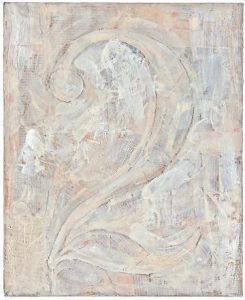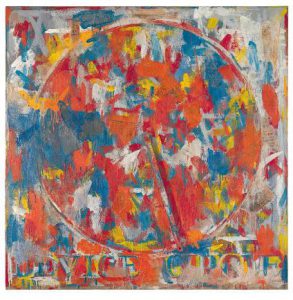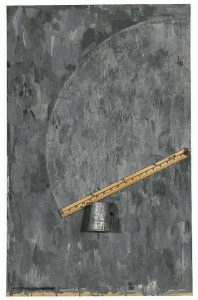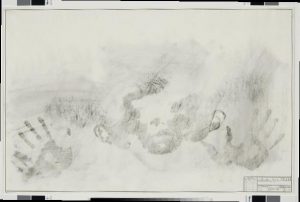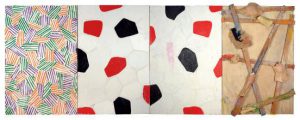Is The Painting Counting?
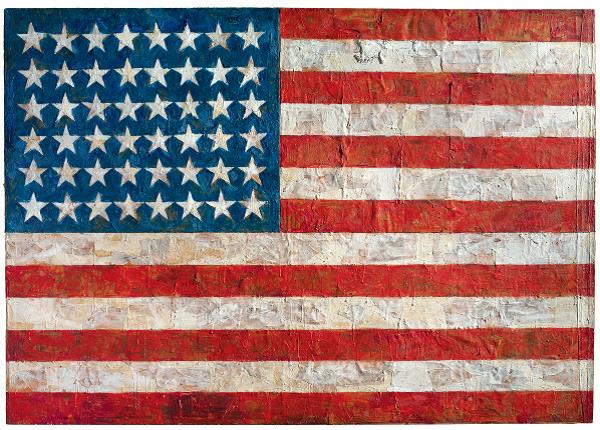
To grasp the excitement (positive and negative) produced by Jasper Johns’s flag and target paintings of the mid- to late 1950s, you have to consider the situation of American painting at the time. That means thinking about Abstract Expressionism. In the mid-1950s, Barnett Newman was still making his zips. Willem de Kooning was churning out shake-and-bake canvases filled with his signature dancing shapes and colours. Jackson Pollock, alas, was dead by 1956, but his all-over-the-canvas drip paintings had become standard-bearers for what ‘serious painting’ should look like. The Ab Exers more or less held sway.
They held sway partly because they were producing visually stunning work, and partly because they were able to express, in both words and paint, a powerful sense of artistic urgency. Abstract Expressionists were given to asking big questions like: what does painting do? Is painting about itself? Should painting reproduce what we see in the world, or does it, rather, ‘express’ something in the mind or soul of the painter? Does painting reach beyond the visual into the fundamental building blocks of reality, be those mental, physical, or spiritual?
Painting in America in 1955 was, in short, a heady affair. To be a painter was to have accepted a kind of ideological calling. In 1943, Mark Rothko, Adolph Gottlieb and Barnett Newman wrote a short manifesto in the form of a letter to the art editor of the New York Times in which they claimed: ‘to us art is an adventure into an unknown world, which can be explored only by those willing to take the risks.’ They also wrote: ‘It is our function as artists to make the spectator see the world our way not his way.’1 Rothko, Gottlieb and Newman wanted serious painting to fly in the face of everyday perception. Standing in front of one of Newman’s imposing zips, one is inclined to feel that the painting hovers at the very edge of what the mind can grasp.
Within this portentous (if not pretentious) mid-century painterly milieu, a young artist named Jasper Johns covered three separate pieces of bedsheet with encaustic and collage and made the entire surface into an American flag. This was, indeed, a risky move. But not risky in the way that Rothko, Gottlieb and Newman meant. If Newman’s paintings took the risk of trying to represent the unrepresentable, of trying to venture into unknown worlds, Johns’s flag painting, by contrast, seemed to risk utter banality.
It’s no wonder that many of his older colleagues considered Johns a traitor from the start.
Johns was then, as now, something of a Stoic. He sallied forth undeterred. Trying to explain why he felt compelled to paint the American flag, he once famously said that he was seeking to paint ‘things the mind already knows’.2 No more swirls or zips or blobs or abstractions: Johns was going to bring painting right back into the world of known things. Along with his flags, he also began to paint targets. The objective was as clear with the target as it had been with the flag. ‘You know what this is,’ he seemed to say. ‘You’ve seen this thing before. Your eye knows what to do.’ Indeed, everybody knows how to look at a flag or a target.
Johns’s flags and targets intrigued precisely because they were so seemingly commonplace. So commonplace, in fact, that they begged for another look. A second look at a Jasper Johns flag or target tends to produce a flicker of doubt. We know how to see these objects without necessarily knowing how to see them. That’s to say, a Johns painting of a flag or a target occupies a strange place in the world of things. The flags and targets are both paintings of objects in the world, and actually are those things in the world. Johns’s painting of a flag is a painting of a flag – and it also is a flag.
Jasper Johns, Flag, 1954 – 55. Encaustic oil and collage on fabric mounted on wood, 104.8 x 105.4 cm. Museum of Modern Art, New York. Gift of Philip Johnson in honour of Alfred H. Barr
Johns’s was a clever response to the problem of painting’s relationship to the real world. That problem had been haunting painting since the mid-nineteenth century: why make illusionistic images of the real world on a two-dimensional canvas? Johns’s early paintings skirt the issue by creating images that are what they represent. Just look at one of his targets. You could easily imagine throwing a dart at it, but at the same time, the painting is, of course, more than a target. It is also about targets.
As Johns continued to experiment with his target paintings, he often played with our sense of how a target is supposed to look. He took away the colour. He added colours we don’t expect. He pushed the limits while, at the same time, maintaining a ‘targety’ essence. The more of Johns’s targets and flags you look at, the more these utterly mundane objects mutate into the most complex and elusive of artworks, and then back again into simple things.
Jasper Johns, Figure 2, 1955. Encaustic and collage on canvas, 43.8 x 35.6 cm. Private collection
Johns had achieved that rarest of artistic feats: the genuine breakthrough. As he experimented throughout the late 1950s and early 1960s, he opened up new areas in which paintings could be both things-in-the-world and paintings of those things. Within this context, it was a natural and understandable ‘next move’ for Johns to paint numbers and letters. These, too, are things ‘the mind already knows’.
Ask yourself these questions: if I paint the number ‘2’ on a canvas, have I brought that number into existence? Is the painting now a ‘2’? Or is it a painting of a ‘2’? And what’s the difference between the painting and the number? When you get tired of these questions, here are some more. Do numbers have colours? Does it make a difference if the number 2 is bigger or smaller? If I paint a series of numbers on a canvas, say 0 to 9, is the painting counting? Is the viewer of the painting counting when she looks at the numbers? You can also perform some of these experiments with individual letters or with the whole alphabet. Johns did that.
Along with ‘things the mind already knows’, Johns experimented with ‘things a painting can do’. In a notebook from 1963–64,3 he jotted down for himself the following instructions:
Take an object
Do something to it
Do something else to it
This notebook jotting has become a kind of oracular document for those seeking to understand Johns’s art and process. It captures perfectly the laconic mood in which he thinks and works. Though the notebook entry is from 1963–64, this had been Johns’s approach to art-making from the beginning.
The results of such actions upon objects can be seen in many of Johns’s paintings of the late 1950s and early 1960s. In 1959, for instance, he made a painting called Device Circle. He took a little wooden bar (the ‘device’) and affixed it to the middle of a square canvas. He put encaustic and newspaper and paint splotches on the canvas, just like he’d done with his first flag painting. Then he rotated the wooden arm, scratching a circle into the paint and encaustic with the far end of the device. Below the circle, he added the words ‘Device Circle’, using the same lettering as he did for The (1957; cat. 60) and Tennyson (1958; see cat. 64).
Jasper Johns, Device Circle, 1959. Encaustic and collage on canvas with object, 101.6 x 101.6 cm. Private collection, New York
Johns was obviously pleased with the ‘device circle’. He did another version of it in Good Time Charley (1961), where a ruler acts as the device, wiping grey paint in a semicircle. Then he painted Device (1961–62), where two stretcher bars wipe half circles at the top of the painting. And in 1962 he made another painting called Device (cat. 85), this time with two rulers and two half circles on either side of a wood slat that divides the work. In Fool’s House (1961–62; cat. 83), he switched from a ruler to a broom, affixing the broom to the top of the painting with a metal hook that allowed it to swing against the canvas, wiping the paint with a slight arc that is the barest beginning of a circle.
Jasper Johns, Good Time Charley, 1961. Encaustic on canvas with objects 96.5 x 61 cm. Collection Mark Lancaster
Then, in 1963, with the painting Periscope (Hart Crane) (cat. 67), the device of the ‘device circle’ is transformed into a human arm. The idea of using a human body part as the device seems to have come to Johns from the Study for Skin works of 1962. In these works, Johns used charcoal to make imprints of his own hands and face on pieces of drafting paper. He did a slightly earlier version of the arm in the drawing Diver (1962–63), where human arms again play the role of devices, wiping a semicircle at the bottom. The seam down the middle (which is where two sheets of paper mounted on canvas panels meet) creates the image, with the semicircle at the bottom, of an anchor.
Jasper Johns, Periscope (Hart Crane), 1963. Oil on canvas, 67 x 48 inches.
Johns was moving into new territory. But he hadn’t completely discarded his old ideas. As with the flags and targets, with the device circles he seems to have been seeking a way to create without, exactly, being the creator. The device circles are mechanical devices, albeit of the most rudimentary kind. Nevertheless, it is the devices that make the circles, not Johns. Having said that, Johns made the devices. So, he is both responsible and not responsible for the marks. Johns has always enjoyed occupying this indeterminate position: the artist as cipher, medium, oracle, channel. He viewed himself not as the great ex-nihilo creator, but rather as the one who helps us to see what was always there. He is the conduit through which art happens.
In the skin drawings, Johns made his body the ‘conduit’, using his hands and other parts of his body. That’s what artists do, isn’t it? They use their hands (craft) and heads (ideas) to make artwork. But in the skin drawings Johns immediately distances himself from this kind of making. He hasn’t drawn anything – he has just put baby oil on his hands and face, pressed them against the paper and then applied charcoal, which is absorbed by the oily patches. His ‘hand’ and ‘head’ made the work, but his hand and head weren’t really doing anything more than lending their images (which ‘the mind already knows’) to the ‘drawings’.
Jasper Johns, Study for Skin 1, 1962. Charcoal on paper, 55.9 x 86.4 cm. Collection of the artist
Periscope (Hart Crane) combines many of these art-making tools and devices into a single work. The painting is mostly grey, though hints of red, blue and yellow come through. There are three sections: the top one is labelled ‘red’, the middle section is ‘yellow’ and the bottom section is ‘blue’. There is a device inscribing a half circle at the top right side of the painting.
The ‘arm’ of the device circle is an arm print.
The title of the painting is a reference to Hart Crane’s poem Cape Hatteras (1929), which is itself a section of Crane’s epic poem The Bridge..4 Cape Hatteras is, among other things, a tribute to Walt Whitman. The last lines are:
Not soon, nor suddenly, – no, never to let go
My hand
in yours,
Walt Whitman –
so –
Thus the arm print that acts as the device in Periscope (Hart Crane) takes on greater resonance as the hand of Walt Whitman, or perhaps the hand of Crane, or even the hand of Johns grasping for Crane’s grasping for Whitman’s. But that’s not all. Just a few years after writing Cape Hatteras, Hart Crane was on a ship in the Gulf of Mexico heading towards New York City. Drunk and severely depressed, he had been rebuffed and perhaps roughed up after a failed amorous advance towards a sailor on the ship. Suddenly, Crane threw himself overboard. A number of witnesses reported seeing a hand shooting up from the waves before sinking down forever.
So the arm of Periscope is also the arm of Crane reaching out one last time from the deep (note the watery quality of the grey and blue of the painting, and the letters ‘floating’ in the paint/ water). The device circle also relates to the ‘periscope’ of the title. Crane’s poem contains the following lines:
What whisperings of far watches on the main
Relapsing into silence, while time clears
Our lenses, lifts a focus, resurrects
A periscope to glimpse what joys or pain
Our eyes can share or answer – then deflects
Us, shunting to a labyrinth submersed
Where each sees only his dim past reversed…
The painting was made two years after Jasper Johns’s romantic relationship with Robert Rauschenberg ended. Johns was, himself, in a kind of emotional hell during that period of his life. The experience changed the way he thought about art. There had been a marked dispassion to the flags and targets and numbers and letters. But the trauma of love lost brought human emotion into Johns’s painting, where it has stayed to this day.
In 1963, Johns was becoming a cipher not just for ‘things the mind knows’, but for things the heart feels. Crane’s approach to poetry was clearly an inspiration. That’s probably because Crane had composed poetry by letting the words and images flow through him on to the page, much as Johns had let the images of daily life flow through him on to the canvas. Crane wasn’t interested in literature that masters meaning, that controls it; he was interested in literature that lets meaning happen. He wanted his poetry to ‘be’ the mystery of meaning, to enact it.
Crane was intrigued by the word ‘crypt’ and its derivation from the Greek kryptos. Paul Mariani wrote about this in his biography of the poet:
Crypt, kryptos: something hidden, something concealed. It is a key concept for Crane, as for all the Romantics. Bodies hidden, meanings concealed. The dead tell no secrets. Crane knows, though – as he had iterated earlier in ‘At Melville’s Tomb’ – they maddeningly intimate them, much as seashells, washed up on the beach, give us intimations of the secrets of the great sea, and so of our origins of ourselves and of our destinies.5
Meaning, here, is something that bubbles up in glimpses. Meaning is at its most meaningful when it is partial, when it is hidden.
Art does not uncover what is hidden, or resolve itself into clear, declarative statements – this means this, that means that. Rather, in art, meaning is a glimpse of reality, like something seen through a periscope. This glimpse is passed on, from Whitman to Crane to Johns to us. The import of this message cannot be explained as such. It isn’t a message from the grocer. It is a message from the deep.
That is, perhaps, why many of the letters that form the names of colours (red, yellow, blue) in Periscope (Hart Crane) themselves seem to be drowning. They fade away into the grey, into the sea. This is the depth from which meaning comes – the deep sea, the unsayable from which saying emerges. But a hand leaps out. A connection is made. Words do this sometimes – they float up from the abyss and facilitate acts of understanding between human beings. Images can do the same thing, at times, as can paintings. The final reach of the hand, the final glimpse from the periscope before going under.
Not that Periscope (Hart Crane) is a treatise on language. It’s more like a game. Johns is experimenting with the letters and the words and the other ‘prime elements’, just as he had done from the beginning with his flags and targets. He combined these elements to find out what sort of meaning might arise. This is very much what the writers and poets Johns has always admired do in their writing. They have a feel for language, difficult to describe or put rules to. Johns once told an interviewer: ‘I was talking to the poet Anne Waldman the other day, trying to get her to explain to me how [Ted Berrigan’s] sonnets were written. She gave me a few clues, but she didn’t seem to think there was any systematic order. He used the same lines over and over, and in some of the poems the lines were shuffled about in an entertaining way so that they read backwards instead of forwards…. So James Merrill uses a Ouija board when he writes his poems? I would love a device like that for painting. Everybody could take the end of the brush and move it on the canvas! Hah, I could really use that!’6
Notice Johns’s lack of concern about who, or what, is ultimately in control of art. This is an example of what I would call the ‘metaphysical trust’ that has always characterised his work. The meaning will come forth of its own accord. The images will be compelling because any image is compelling if we allow ourselves the time and occasion genuinely to look.
For Johns, great poets are those who let language do what it will. They have the trust to let the words arrange themselves. There is a kind of guiding hand, of course, just like with the Ouija board. But the exact relationship between the guiding hand and the eventual work of art has a mysterious quality. This does not bother Johns, as it did not bother Crane or Beckett or Céline or Tennyson or Ted Berrigan or Frank O’Hara, all of whose literary work has been referenced, explicitly or implicitly, in the art Johns has produced since the late 1950s.
In the early 1970s, Johns was given the opportunity to collaborate directly with Samuel Beckett on Foirades/Fizzles (cat. 110), a book containing a series of short prose pieces written by Beckett in 1960. The following lines may have resonated with Johns in respect to Hart Crane: ‘perhaps he’ll drown, he always wanted to drown, he didn’t want them to find him, he can’t want now any more, but he used to want to drown, he usen’t to want them to find him, deep water and a millstone.’
Jasper Johns, Untitled, 1972. Oil and encaustic on canvas with collage and objects, 182.9 x 488.3 cm. Museum Ludwig, Cologne, Ludwig Donation
Johns’s artwork for Fizzles took up visual material from his 1972 painting Untitled. That painting features flagstone and crosshatching patterns that have appeared and reappeared in Johns’s work ever since. According to Johns, he glimpsed the flagstone pattern on the storefront of a building in Harlem. The flagstones weren’t flagstones, exactly, but a wall painted ‘to look like’ flagstones. That’s to say, this wall of painted flagstones was itself the mixture of reality and the painting of reality that has intrigued Johns throughout his career. Need we even mention that the word ‘flag’ is embedded in the word ‘flagstone’?
In a relatively recent work entitled simply Beckett (2005;cat 70), Johns reproduced the flagstone pattern in a monochrome grey, painting the grey flagstones on two canvas panels (a diptych?) with thin wooden slats along the side that can be opened. The ‘false diptych’ with its mute flagstones points to a theme running through the work of both Beckett and Johns. This theme can be articulated, roughly, as the following: the deeper ‘the self’ is interrogated and the more obsessively the artist expresses this self, the less the artist finds. In the final analysis, the search for something deep becomes a plunge into the depths of nothingness. The wooden slats of Beckett ‘open up’ only to reveal an extra sliver of grey flagstone. Something is revealed, but this revelation is nothing of substance. A stone wall remains a stone wall.
Beckett, like Periscope (Hart Crane), is not a puzzle to be solved. It is, in the end, a simple painting composed of simple images. Yet those images are resonant with metaphors of the sea, of depths, of longing, loss, secrets and the mystery of meaning.
Jasper Johns has done some version of the following, in one form or another, in dozens of interviews over the years. He’ll halt the interview in the middle of a flight of over-analysis (his or the interviewer’s) and say, with some finality: ‘I just make the pictures.’ Everything beyond that is beyond his control. As Walt Whitman wrote in Leaves of Grass:
I bequeath myself to the dirt to grow from the grass I love,
If you want me again look for me under your boot-soles.
You will hardly know who I am or what I mean,
But I shall be good health to you nevertheless,
And filter and fibre your blood.7
This essay, prepared for the exhibition ““Something Resembling Truth” at the Royal Academy of Arts., is reproduced with the permission of the Royal Academy and Morgan Meis.


